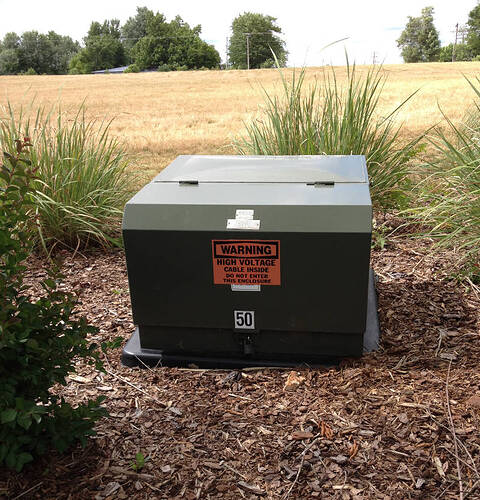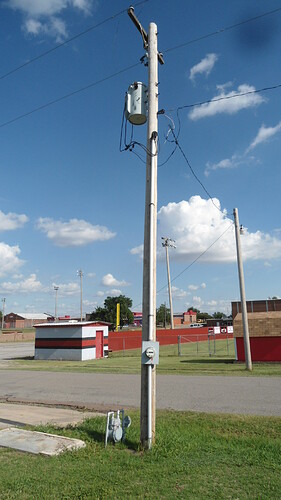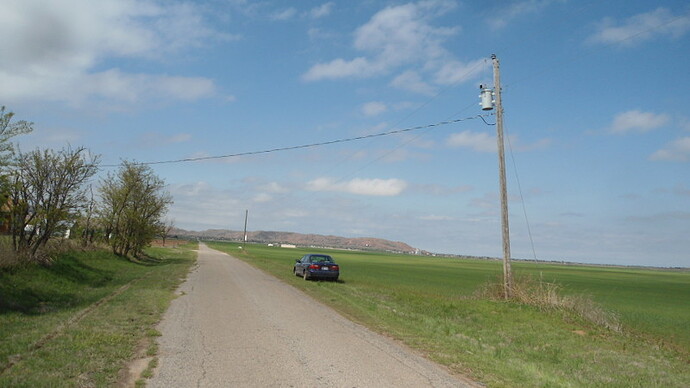A common question is “I have 200 Amp service, do I need a 200 Amp CT?”
The answer is most likely no.
Unless you have a very large house, a 100 Amp CT would be a better choice.
(Large houses, typically have 320 or 400 Amp service and may actually need a 200 Amp CT, but this article addresses 200 Amp service installations)
So what does the term 200 Amp service refer to?
Simply put, it means the weakest link in your Service Entrance Wire, Meter Base, Meter, Main Breaker, Load Center (circuit breaker box) chain is rated at 200 Amps,
If the transformer that feeds your house is visible, i.e. it’s pole or pad mounted vice an underground unit, you can easily determine its rating. The number you’ll see on the transformer is likely to be 15, 25, 37.5 or 50. You might see a number greater than 50, but the likelihood of that is very low.
Here’s an example, of a 25 kVA pole mounted transformer:
Here’s an example of a 50 kVA pad mounted transformer.
Once you know the transformer rating, the maximum continuously available current can be calculated with the simple equation kVA x 1000 / 240 = Imax
e.g. for a 15 kVA transformer: 15 x 1000 / 240 = 62.5 Amps
In addition to the transformer rating, you need to know the total number of houses connected to the transformer. That should be easy to determine by looking at the transformer and counting the sets of wires that run between it and all of the houses it’s connected to, including yours.
Your transformer-to-house wiring may be underground even though the transformer itself is pole-mounted.
Here’s an example:
This is an example of an overhead service drop:
If the number on the transformer is 15, your house is more than likely to be the only house connected to the transformer as in the example above. Some utility companies connect two small houses to a 15 kVA transformer.
If the number on the transformer is 25, the number of houses connected to the transformer in addition to yours, can range from one to three. Note: your house may be the only one connected to the transformer if you have a large house.
So how does all of this affect you?
Here’s the breakdown:
If you’re the only house connected to a 15 kVA transformer, the maximum continuously available current is 62.5 Amps. If there’s another house in addition to yours, connected to the transformer, the 62.5 Amp maximum is split between the two houses.
If you’re connected to a 25 kVA transformer, the maximum continuously available current is 104 Amps, but split N ways, with N equal to the total number of houses connected to the transformer.
If more than four houses are connected to one transformer, the number on the transformer might be 37.5 or 50, but the maximum continuously available current is divided between the houses as described in the 15 and 25 kVA transformer examples above.
If your house is the only one connected to a 37.5 kVA transformer - as a very large house might be - the maximum continuously available current is 156.25 Amps.
The bottom line?
Even if your house is the only house connected to the transformer, unless the transformer is
rated at 50 kVA or more, you don’t actually have 200 Amps available continuously.
The transformers can deliver 150% of their maximum rating for short periods of time, generally not more than a few minutes. Thus they are able to supply the large demand known as inrush current, when devices like air conditioner compressors are started.
The system works because each household doesn’t usually operate all, or a large number of, electrical loads at the same time. The same principle applies when more than one house is fed from the same transformer. The chances of all the households operating all, or a large number of loads at the same time are very low.
The same principle also applies to your load center. (circuit breaker box)
It’s very common for the total Ampere rating of the branch breakers in a load center to far exceed the rating of the load center. That’s because you don’t usually have every load in your house powered on at the same time.


